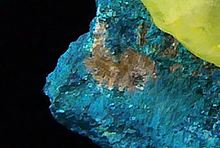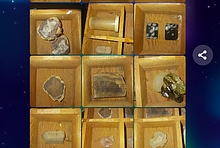Home PageAbout MindatThe Mindat ManualHistory of MindatCopyright StatusWho We AreContact UsAdvertise on Mindat
Donate to MindatCorporate SponsorshipSponsor a PageSponsored PagesMindat AdvertisersAdvertise on Mindat
Learning CenterWhat is a mineral?The most common minerals on earthInformation for EducatorsMindat ArticlesThe ElementsThe Rock H. Currier Digital LibraryGeologic Time
Minerals by PropertiesMinerals by ChemistryAdvanced Locality SearchRandom MineralRandom LocalitySearch by minIDLocalities Near MeSearch ArticlesSearch GlossaryMore Search Options
The Mindat ManualAdd a New PhotoRate PhotosLocality Edit ReportCoordinate Completion ReportAdd Glossary Item
Mining CompaniesStatisticsUsersMineral MuseumsClubs & OrganizationsMineral Shows & EventsThe Mindat DirectoryDevice SettingsThe Mineral Quiz
Photo SearchPhoto GalleriesSearch by ColorNew Photos TodayNew Photos YesterdayMembers' Photo GalleriesPast Photo of the Day GalleryPhotography
╳Discussions
💬 Home🔎 Search📅 LatestGroups
EducationOpen discussion area.Fakes & FraudsOpen discussion area.Field CollectingOpen discussion area.FossilsOpen discussion area.Gems and GemologyOpen discussion area.GeneralOpen discussion area.How to ContributeOpen discussion area.Identity HelpOpen discussion area.Improving Mindat.orgOpen discussion area.LocalitiesOpen discussion area.Lost and Stolen SpecimensOpen discussion area.MarketplaceOpen discussion area.MeteoritesOpen discussion area.Mindat ProductsOpen discussion area.Mineral ExchangesOpen discussion area.Mineral PhotographyOpen discussion area.Mineral ShowsOpen discussion area.Mineralogical ClassificationOpen discussion area.Mineralogy CourseOpen discussion area.MineralsOpen discussion area.Minerals and MuseumsOpen discussion area.PhotosOpen discussion area.Techniques for CollectorsOpen discussion area.The Rock H. Currier Digital LibraryOpen discussion area.UV MineralsOpen discussion area.Recent Images in Discussions
Techniques for CollectorsWaller Method -- Anyone had success with it?
28th Jan 2009 02:15 UTCJason B. Smith Expert
http://homepage.mac.com/rasprague/PegShop/extras/waller/waller1.html
28th Jan 2009 15:34 UTCDavid Von Bargen Manager
Sodium dithionite = sodium hydrosulfite
http://www.summitbrands.com/retail_support/downloads/MSDS/US%20MSDS/MSDS%20Super%20Iron%20Out.pdf
30th Jan 2009 00:41 UTCClaus Hedegaard
All the best
Claus

6th Feb 2009 17:48 UTCAlfredo Petrov Manager

14th Mar 2009 23:45 UTCJohn Duck
Super Ironout plus baking soda will do a good job of cleaning fluorapatite and hydroxylherderite but will dissolve some micro phosphates so some initial testing as described above should be tried with a poorer specimen. I have found that it is not a good idea in general to leave specimens in the cleaning solution for an extended period of time. Multiple cleanings with fresh solution seem to work best. From what I have seen most of the cleaning occurs within the first half hour of immersion in the solution. Often times cleaning is completed within 5 to 10 minutes assuming that the specimen is not heavily coated. Also it is a good idea to soak the specimen in water for at least a half an hour before putting it into the cleaning solution to saturate all the internal pore spaces with water. This makes it easier to ensure that the cleaning solution has been completely removed from the specimen later. After cleaning let the specimen soak in clean water to remove the cleaning solution. I usually change the water twice and then let the specimen soak over night in fresh water. You will have to do a little experimentation to determine what works best for the specimens from your area. Always check one specimen first through the entire process to ensure that the procedure won't damage your samples.
According to Ray Sprague, owner of the Emmons Quarry near Norway, Maine, ammonia is recommended for cleaning micro phophates because it leaves no residue like baking soda does. Ray claims to have good success with this method for Emmons Quarry phosphates, although I have not yet tried this method personnally.




Mindat.org is an outreach project of the Hudson Institute of Mineralogy, a 501(c)(3) not-for-profit organization.
Copyright © mindat.org and the Hudson Institute of Mineralogy 1993-2024, except where stated. Most political location boundaries are © OpenStreetMap contributors. Mindat.org relies on the contributions of thousands of members and supporters. Founded in 2000 by Jolyon Ralph.
Privacy Policy - Terms & Conditions - Contact Us / DMCA issues - Report a bug/vulnerability Current server date and time: April 18, 2024 00:37:39
Copyright © mindat.org and the Hudson Institute of Mineralogy 1993-2024, except where stated. Most political location boundaries are © OpenStreetMap contributors. Mindat.org relies on the contributions of thousands of members and supporters. Founded in 2000 by Jolyon Ralph.
Privacy Policy - Terms & Conditions - Contact Us / DMCA issues - Report a bug/vulnerability Current server date and time: April 18, 2024 00:37:39











